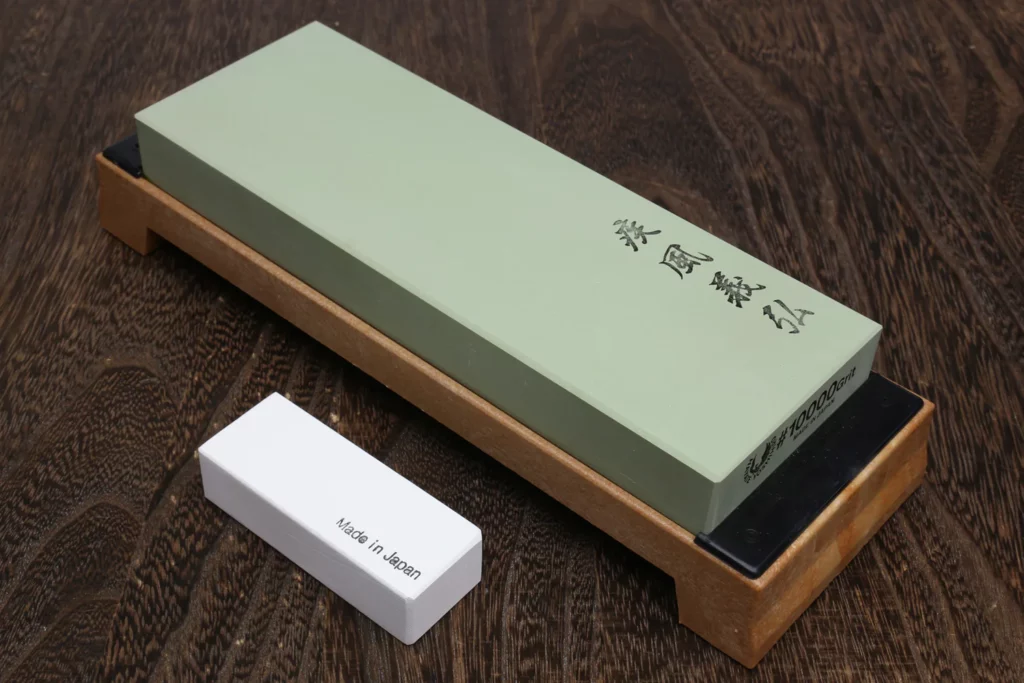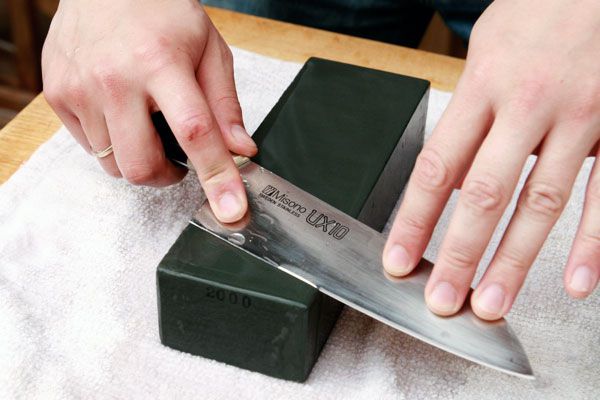Every cook has to know how to sharpen knives, and what grit whetstone for kitchen knives. A sharp knife simplifies and protects the task of slicing tomatoes for a salad or carving a roast. While you may get your knife sharpened by a professional, you can also use a whetstone to do it yourself at home.
A textured stone used to sharpen knives is called a whetstone. There are several kinds of whetstone grits, and each one has a unique function. The individual grains or flakes that constitute a whetstone’s grit vary in size. A finer stone is indicated by a higher grit number, while a coarser stone is represented by a lower one.
For the greatest results, selecting the right whetstone grit is essential. In general, you should finish your blade with a finer grit whetstone and sharpen it with a coarser grit whetstone.
The different kinds of whetstone grit, how to pick the best one for your needs, and how to use and take care of it are all discussed in this article.
Recognizing The Whetstone Grit
Types of Grit
In general, there are three types of whetstone grit:
Coarse Grit (200-800): These whetstones work well for sharpening very dull knives or restoring damaged blades. They might leave a harsh edge but remove material fast.
Medium Grit (1000–3000): Medium-grit stones can be used for a variety of purposes, including maintaining the edge of frequently used knives. They manage to remove debris quickly while maintaining a flawless finish.
Grit Fine (4000–8000): An existing sharp edge is polished and sharpened to a razor-sharp finish using fine-grit stones. They leave behind a perfect, mirror-like edge and minimal substance.

The Importance of Grit for Whetstones
For the necessary sharpness and edge quality, choosing the proper grit is essential. A blade can be harmed by a poor edge or excessive material removal caused by using the incorrect grit.
Typically, you’ll begin by shaping the edge with a rougher stone before moving on to a finer stone to refine it.
How to Choose the Right Grit Whetstone
For Kitchen Knives
- Coarse Grit Kitchen Knives (200-800): If your kitchen knife is really dull or damaged (such as chipped or nicked), use a coarse grit whetstone. Avoid removing too much material, as doing so might weaken the blade.
- Medium Grit (1000-3000): Most kitchen knives will benefit from routine maintenance with a medium grit whetstone (1000–3000). This grit is excellent for preserving a sharp edge and eliminating any minor burrs or nicks. It’s also a wonderful place for newbies to start.
- Fine Grit (4000–8000): To achieve a razor-sharp finish on your kitchen knife’s edge, use a fine grit whetstone. If you desire a mirror-like edge and don’t mind putting in extra time and work, this grit is perfect for you.
The material of the blade should be taken seriously when selecting a whetstone for your kitchen knife. For example, softer steel knives (like those made of German steel) may need a coarser grit whetstone than tougher steel blades (like those made of Japanese steel).
For Additional Blades and Tools
The type of blade and its intended function will decide the grit that should be used for various tools and blades.
In general, broken blades are repaired or reshaped with coarse grits, whereas honing and polishing are done using fine grits. For example:
Chisels and plane blades: Chisels and plane blades are sharpened and maintained using medium grits (1000–3000), while coarse grits (200–800) are used to fix chips and nicks.
Axes and machetes: Coarse grits (200-800) are used to polish and sharpen, while medium grits (1000-3000) are used to remove nicks and damage.
Straight razors: The blade is polished and sharpened to a razor-sharp finish using fine grits (4000–8000).
Proper Use and Maintenance of Whetstones
It’s necessary to use and maintain your whetstone correctly if you want to get the greatest results from it. Here are a few advises:
- Before use, place the whetstone in water for 10 to 15 minutes, unless it’s a diamond stone, in which case no soaking is necessary.
- Put the whetstone down on a non-slip surface.
- Move the blade back and forth over the stone while putting in equal pressure at the proper angle, which is often approximately 20 degrees.
- If you’re not sure of the proper angle, consult an honing guide.
- Rinse the stone often to get rid of dirt and metal shavings.
- The stone should be carefully rinsed after usage and allowed to completely dry before being stored.
FAQs
Can I sharpen serrated knives on a whetstone?
Serrated knives shouldn’t be whetted using a whetstone because the uneven teeth make it challenging to maintain the proper angle. Use a serrated knife sharpener or a sharpening rod instead.
How frequently should my kitchen knives be sharpened?
This will depend on how frequently and for what purposes you use your knives. Generally speaking, most kitchen knives benefit from frequent honing in between sharpening that occurs around every few months. However, you might need to sharpen your knives more regularly if you use them frequently or for work-related tasks.
Can I grease my whetstone with oil instead of water?
Whetstones should not be coated with oil unless the manufacturer clearly specifies that doing so is safe. Some stones’ pores can become clogged with oil, which reduces their effectiveness.
Conclusion
Knives and other tools may be sharpened with whetstones, but it can be challenging to select the proper grit. As a starting point for routine maintenance, start with a medium grit stone and keep in mind the type of blade and its intended use.
A whetstone may keep your blades sharp for many years if used and maintained properly. Cheers to honing!
